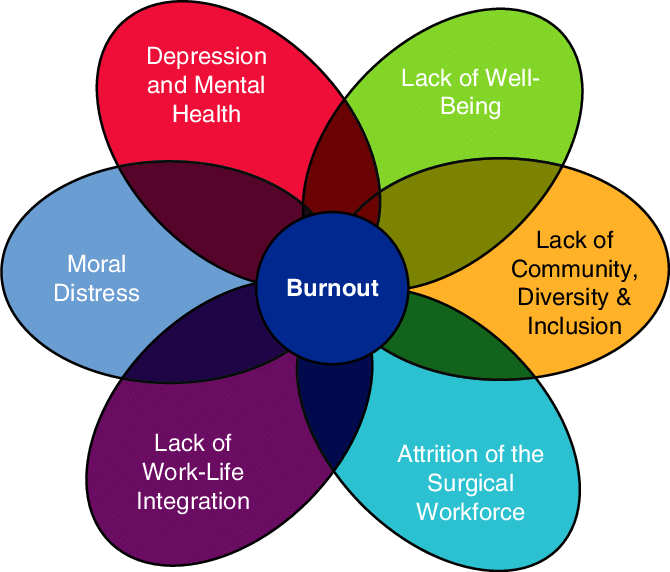In today’s workplace, the word “burnout” seems to be a very common term, probably because of the dynamic and ever-demanding nature of today’s work environment with perceived insufficient resources to meet up this demand on the part of the workers. But what exactly is burnout? This article seeks to discuss what job burnout is, the consequences of burnout, the factors responsible, and how burnout can be managed in the workplace.
Burnout
Burnout is a response to stress from one’s job characterized by exhaustion, cynicism, and professional inefficacy. Exhaustion occurs when a person has overstretched herself so much that she feels drained and incapable of meeting up with the job’s demands. The signs of exhaustion include fatigue, fear, touchiness, annoyance, and nervousness (Maslach et al., 2001; Zaid, 2019). Cynicism is marked by a person showing inappropriate attitudes (such as hatred, irritability, and withdrawal) toward their job (Maslach & Leiter, 2016). Professional inefficacy is marked by the person experiencing low morale, a decrease in productivity, dissatisfaction with one’s work, and low self-confidence in one’s ability to manage the stress from work. The individual may resort to thinking that “maybe I am not good enough; or coming to this place may be a wrong decision” (Maslach et al., 2001; Maslach, 2021). These three responses of exhaustion, cynicism, and inefficacy are what sets burnout apart. Burnout usually occurs when stress from one’s work is not well managed. It is a sign that there is a problem in the workplace and not an individual problem per se.
Consequences of Burnout
Burnout has negative consequences on the employees as well as the organization. Burnout can lead to job dissatisfaction, low commitment to the organization, absenteeism, turnover intention, and turnover itself (Schaufeli & Enzmann, 1998; Leiter & Maslach, 2009; Laschinger, et al., 2012). Burnout also diminishes the quality of work and productivity. Furthermore, individuals that are burnt out are likely to have interpersonal conflicts with other employees in the organization (Gascón et al., 2013). Burnout can also lead to physical illnesses such as heart and lung diseases, and mental illnesses such as anxiety disorder and depression (Zaid, 2019; von Känel et al., 2020).
Risk factors for Burnout
Research has identified six major factors being responsible for job burnout and these include work overload, control, reward, community, fairness, and values (Maslach & Leiter, 2016).
Work overload: burnout occurs when the job demands so much from individuals leaving them with little or no time to rest and recover from the stress of work.
Control: A lack of control can lead to burnout. It can also affect an employee’s ability to influence their work. Having the autonomy to make decisions that affect their work can help them feel more engaged in their job.
Reward: Insufficient recognition and reward can lead to burnout, as it undermines both the work and the worker’s sense of worth. It also makes people more vulnerable to feelings of inefficacy.
Community: The community that employees have on the job is very important, as it can affect their health and well-being. When these relationships are not healthy, then there is a higher risk of burnout.
Fairness: In the workplace, fairness refers to the perception of fairness and equity in decisions. Feelings of cynicism, hostility, and anger are likely to result when people do not feel respected and treated equally.
Value: value here has to do with the pride and sense of fulfillment employees get from contributing something meaningful and ethical to the organization. Burnout sets in when the employees feel their work conflicts with their values.
How To Manage Burnout in the Workplace
Burnout as earlier stated is a response to chronic stress in the workplace that has not been well managed. The best approach to managing burnout should be to help the employees cope with the stress while working to eliminate the source of stress as an organization. Based on this approach, the following steps could be taken to manage workplace burnout.
Adjusting work pattern: this involves creating room for breaks, and vacation, minimizing overtime work, and maintenance of some level of balance between work and life.
Social support: coping skills can also involve getting some level of emotional support from one’s family and colleagues at work.
Training in coping skills and relaxation: the employees can be trained on how to handle conflict, assess, and react to stressful events, and effective time management. Also, health and fitness programs can be incorporated into the activities of the organization.
Counseling: counseling services can be provided to the employee to help them manage stressful situations.
A sense of community: the organization should be structured in a way that reflects a sense of community marked by fairness, and a match between individual and organizational values.
Flexibility: some level of flexibility should be provided in the organization to enable the employees to do things a little differently and to innovate. Rather than being rigid, some level of control over one’s work should be allowed.
Recognition: employees should be consistently rewarded for jobs well done. Recognition can be a material or non-material reward. Reward always acts as a reinforcer that shapes behavior. Consistent rewards encourage the feeling of satisfaction which can enhance performance.
Burnout is a sign that there is a problem in the workplace and not an individual problem. Hence, rather than looking for who has the problem, the goal should be to make the workplace more fitting and not to get rid of the employee “who seems not to fit in” and this has been echoed by renowned Professor Christina Maslach, an expert in this field; “so a real solution is not simply to say, If you can’t take the heat, get out of the kitchen. It’s like, okay, we’ll help you cope and do better in this kind of environment, but we’re also going to work on the kitchen to make it a better place to do that kind of work.”
NOTE
In line with our mantra of leading the crusade of mental wellness in Africa, The Institute of Counseling organizes WORKPLACE MENTAL HEALTH AWARENESS TRAINING for optimal performance in corporate organizations.
Informed organizations understand that corporate training has moved from the traditional style to a more progressive one, concentrating on ROI rather than KPI, no employee can function optimally or perform efficiently if his/her mental health is not taken into consideration.
As the foremost professional counseling Institute in Africa, We understand the relationship between mental health and corporate productivity, as well as its impact on overall employee functionality.
There is no health without mental health, and our specialized Mental Heath training is what organizations need to achieve their corporate mandate. Understanding that the concept of mental health can be a complicated or largely misunderstood one, we have broken down our training into easily applicable that is highly beneficial for organizational growth and optimal functionality of the staff.
CLICK HERE TO BOOK A SESSION FOR YOUR ORGANISATION. YOU CAN ASLO CONTACT +2348187114851 OR registrar@instituteofcounseling.org
References
Gascón, S., Leiter, M. P., Andrés, E., Santed, M. A., Pereira, J. P., Cunha, M. J., … & Martínez‐Jarreta, B. (2013). The role of aggressions suffered by healthcare workers as predictors of burnout. Journal of clinical nursing, 22(21-22), 3120-3129.
Laschinger, H. K. S., Wong, C. A., & Grau, A. L. (2012). The influence of authentic leadership on newly graduated nurses’ experiences of workplace bullying, burnout and retention outcomes: A cross-sectional study. International journal of nursing studies, 49(10), 1266-1276.
Leiter, M. P., & Maslach, C. (2009). Nurse turnover: the mediating role of burnout. Journal of nursing management, 17(3), 331-339.
Maslach, C. (2021). Speaking of Psychology: Why we’re burned out and what to do about it. https://www.apa.org/news/podcasts/speaking-of-psychology/burnout
Maslach, C., & Leiter, M. P. (2016). Understanding the burnout experience: recent research and its implications for psychiatry. World psychiatry, 15(2), 103-111.
Maslach, C., Schaufeli, W.B., &Leiter, M.P. (2001).Job burnout.Annual Review of Psychology, 52, 397-422.
Schaufeli, W., & Enzmann, D. (1998). The burnout companion to study and practice: A critical analysis. CRC press.
von Känel, R., Princip, M., Holzgang, S. A., Fuchs, W. J., van Nuffel, M., Pazhenkottil, A. P., & Spiller, T. R. (2020). Relationship between job burnout and somatic diseases: a network analysis. Scientific reports, 10(1), 1-6.
Zaid, W. M. A. B. (2019). The Impact of Job Burnout on the Performance of Staff Member at King Abdul-Aziz University. International Journal of Business and Social Science, 10(4).




